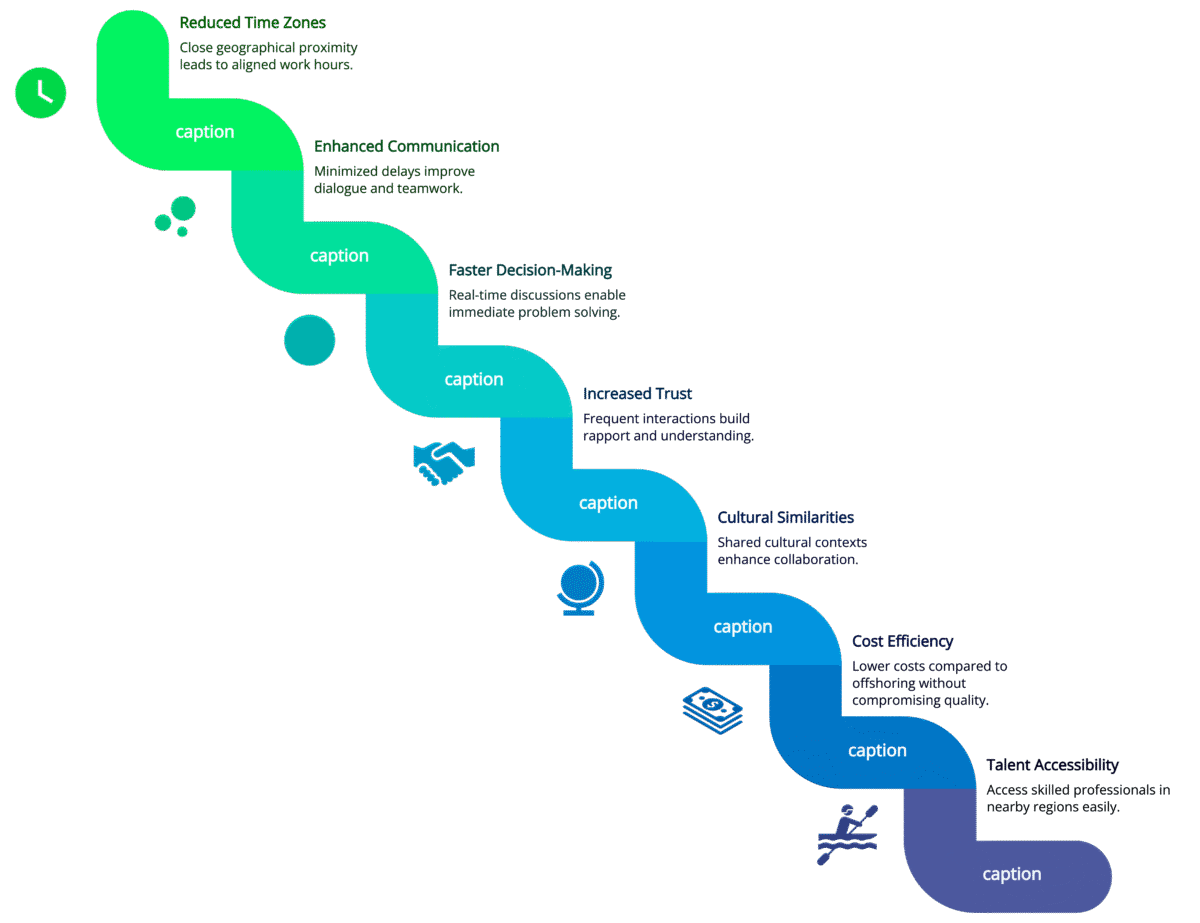
Better alternatives to offshoring for enterprise scaling
For years, offshoring has been sold as a panacea for enterprise scaling challenges: reduced labor costs, faster output, and broader reach. But beneath the glossy promises lies a more complex truth: cultural barriers, quality concerns, and unpredictable management headaches. Many leaders today are finding that while offshoring might save money in the short term, it can erode long-term growth and innovation. So, what’s next?
Thank you for reading this post, don't forget to subscribe!Here’s the kicker: There are better, more sustainable options to scale without the growing pains of offshoring.
Nearshoring for Improved Collaboration

Communication
When teams work across drastically different time zones, communication delays become inevitable. Waiting 12-24 hours for a critical email response can slow down project timelines and cause friction. Nearshoring reduces these delays by aligning work hours more closely. Real-time collaboration via tools like Zoom, Slack, or Teams becomes practical, leading to faster decision-making and troubleshooting. For example, a New York-based enterprise partnering with developers in Colombia can schedule meetings within the same workday.
Cultural Compatibility
One of the hidden costs of offshoring is the cultural divide. Misunderstandings about work styles, hierarchies, and business etiquette can stall productivity. Nearshoring, on the other hand, often provides cultural similarities that ease collaboration. For example, companies nearshoring within the Americas or Europe benefit from shared holidays, business conventions, and communication norms. Employees on both sides “speak the same language” in terms of expectations and workplace dynamics.
Stronger Accountability
Nearshoring providers tend to offer greater visibility into project progress and outcomes. Proximity fosters stronger partnerships, where vendors are incentivized to maintain high performance due to closer business ties. Enterprises can conduct more frequent site visits and workshops, building trust and rapport that are harder to maintain with far-off teams. Regular check-ins also mean project deviations are caught early.
Faster Feedback Loops
In competitive industries, agility is everything. The ability to get feedback quickly, iterate on products, and solve problems rapidly often determines market success. With nearshoring, shorter travel distances and overlapping work hours ensure that iterations happen without lengthy back-and-forth delays. A software development company with a nearshore partner can release updates faster, stay ahead of bugs, and maintain a continuous improvement cycle.
Cost-Effective but High-Value Talent
Nearshoring offers a sweet spot between expensive onshore hiring and lower-cost but potentially riskier offshoring. For example, U.S. companies can leverage skilled talent in places like Costa Rica or Eastern Europe for highly technical roles, often at a fraction of the cost compared to U.S.-based staff. However, these regions still offer strong educational systems and professional development networks, ensuring high-quality work without compromising standards
Hybrid or Distributed Teams
Why tie your business’s future to a single outsourced location when technology has unlocked a new paradigm hybrid, distributed workforces? Enterprises no longer need to depend solely on large-scale offshore centers to expand. With advancements in communication tools like Slack, Zoom, and Asana, as well as cloud-based collaboration platforms, enterprises can now hire top-tier talent across multiple regions without fully relocating operations or compromising control.
Diverse Talent Pools Drive Innovation
Innovation thrives on diversity of thought, and by tapping into a global workforce, businesses can bring together perspectives and skill sets from across the world. Whether you’re hiring software engineers in Eastern Europe, UX designers in Latin America, or data scientists in Asia, a hybrid model allows companies to access niche expertise without geographical constraints. More diverse teams can also better understand and cater to a global customer base, boosting product-market fit in international markets.
Agility as a Competitive Edge
The modern enterprise must adapt rapidly to market shifts, new technologies, and evolving customer demands. By distributing your workforce across regions, you ensure round-the-clock progress without burnout or delays. Need urgent feedback overnight? With distributed teams in different time zones, progress never sleeps. Additionally, if one market experiences a disruption such as political instability, natural disasters, or unforeseen crises your business can pivot operations to unaffected regions.
Reducing Risks Through Operational Redundancy
Consolidating operations in one location offshore or otherwise can be a risky proposition. External risks like labor strikes, regulatory changes, or infrastructural failures in a single hub can grind business operations to a halt. However, when you distribute your workforce across multiple regions, you build operational redundancy. This model provides a safeguard against disruptions, ensuring that business continuity plans are baked into your strategy.
Maintaining Culture and Collaboration Across Borders
One of the concerns with hybrid models is maintaining a cohesive company culture. However, companies that prioritize communication, transparency, and inclusivity have proven that distance is no barrier to strong collaboration. By setting up regular team syncs, virtual events, and shared knowledge platforms, businesses can cultivate a united workforce where everyone feels valued.
Gone are the days when scaling meant setting up shop in a single offshore location and hoping for the best. With today’s technological infrastructure, enterprises have unprecedented flexibility to create globally distributed, resilient, and highly innovative teams. This hybrid model empowers businesses to stay agile, reduce risks, and unlock the true potential of their workforce.
Automation & AI-Driven Solutions

Let’s face it: Some tasks offshored in the past, such as data entry or repetitive processing, can now be automated. By investing in automation technologies, companies reduce reliance on outsourcing for low-value tasks. This frees up budgets to hire higher-skilled, local talent for strategic initiatives. Automation isn’t about cutting jobs it’s about enhancing human productivity and enterprise scalability.
Eliminating Repetitive Work
Remember when businesses had to dedicate entire teams just to data entry or manual reporting? Today, Robotic Process Automation (RPA) tools like UiPath and Automation Anywhere handle these tasks with greater speed and accuracy. Similarly, AI-powered chatbots (think Intercom or Zendesk) manage customer inquiries, providing instant answers and escalating complex issues to human agents only when necessary.
The result? Human employees are freed from repetitive “busy work,” giving them time to focus on creative problem-solving, strategic planning, and innovation.
Cost Optimization Without Sacrificing Quality
One reason companies offshored tasks was the high cost of onshore labor for low-value functions. However, automation changes the equation entirely. Once the upfront investment in automation infrastructure is made, companies can handle these tasks with minimal recurring costs—often for a fraction of what outsourcing would require.
Better yet, automation doesn’t sleep, doesn’t need time off, and performs tasks consistently 24/7. This level of efficiency enhances quality control while keeping operational expenses predictable.
Empowering Local Talent for Strategic Roles
Scaling isn’t just about cutting costs; it’s about scaling smart. By reallocating resources saved through automation, enterprises can hire highly skilled, local talent to drive strategic growth. Imagine investing in roles like data scientists, AI trainers, and UX designers rather than focusing on transactional tasks. This talent adds long-term value by spearheading innovation and business development.
Enhanced Scalability and Agility
Automation also prepares enterprises to respond swiftly to changing business needs. Need to scale customer support during peak seasons? AI tools can increase capacity without the delays of recruiting, training, and managing new hires. Similarly, automation systems can rapidly process massive data loads during market shifts, helping leaders make data-driven decisions in real time.
Collaboration Between Humans and AI

Despite fears of automation “taking over,” the most successful enterprises leverage human-AI collaboration to create hybrid workflows. Think of AI as your business’s super-assistant enhancing human capabilities rather than replacing them. Tools like IBM’s Watson and Salesforce’s Einstein AI are designed to provide insights, recommendations, and predictive analytics, empowering employees to work smarter.
This shift helps create an organization where employees are empowered by technology, not threatened by it.
The Future of Work: Augmented, Not Automated Away
Automation and AI are no longer just futuristic concepts they are tools transforming the way enterprises scale today. Companies that adopt these technologies strategically can enhance productivity, optimize costs, and empower their workforce to innovate. The real competitive advantage lies not in the technology itself, but in how businesses integrate it to enhance their human capital.
Scaling smart doesn’t mean replacing people with machines—it means giving people the tools to build something far greater.
Strategic Partnerships
Rather than offshoring to a distant provider, consider forming joint ventures or partnerships with regional experts. Strategic partnerships enable shared investments and access to specialized markets without sacrificing control. Unlike offshoring, partnerships foster collaboration and co-ownership, leading to better outcomes and knowledge transfer.
Why It Matters
Companies that prioritize control, quality, and brand trust over pure cost-cutting ultimately win in the long term. Enterprises scaling through nearshoring, hybrid models, or automation experience fewer bottlenecks and deliver higher customer satisfaction. Plus, they maintain the agility to pivot and innovate faster than their fully offshored competitors.
Scaling smart doesn’t mean chasing the lowest cost it means choosing solutions that support your business goals with resilience, adaptability, and innovation.


